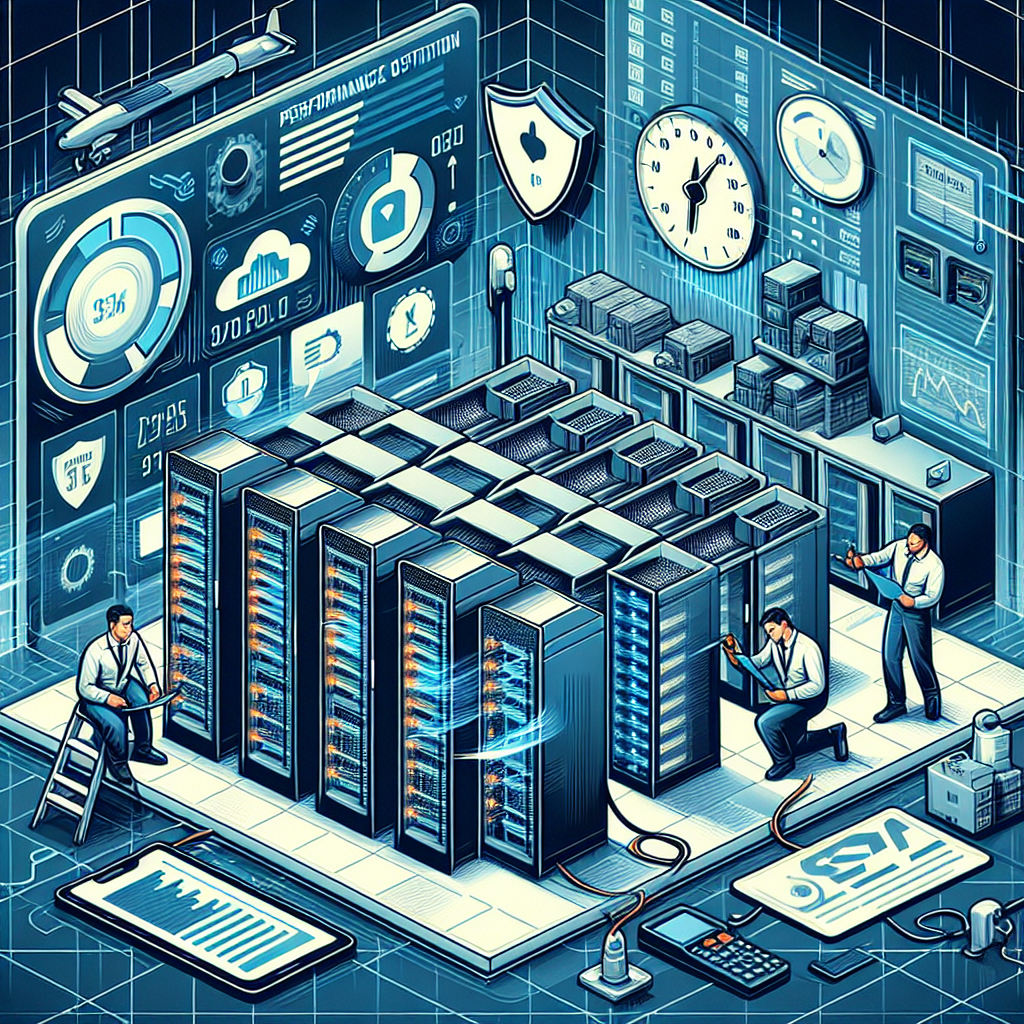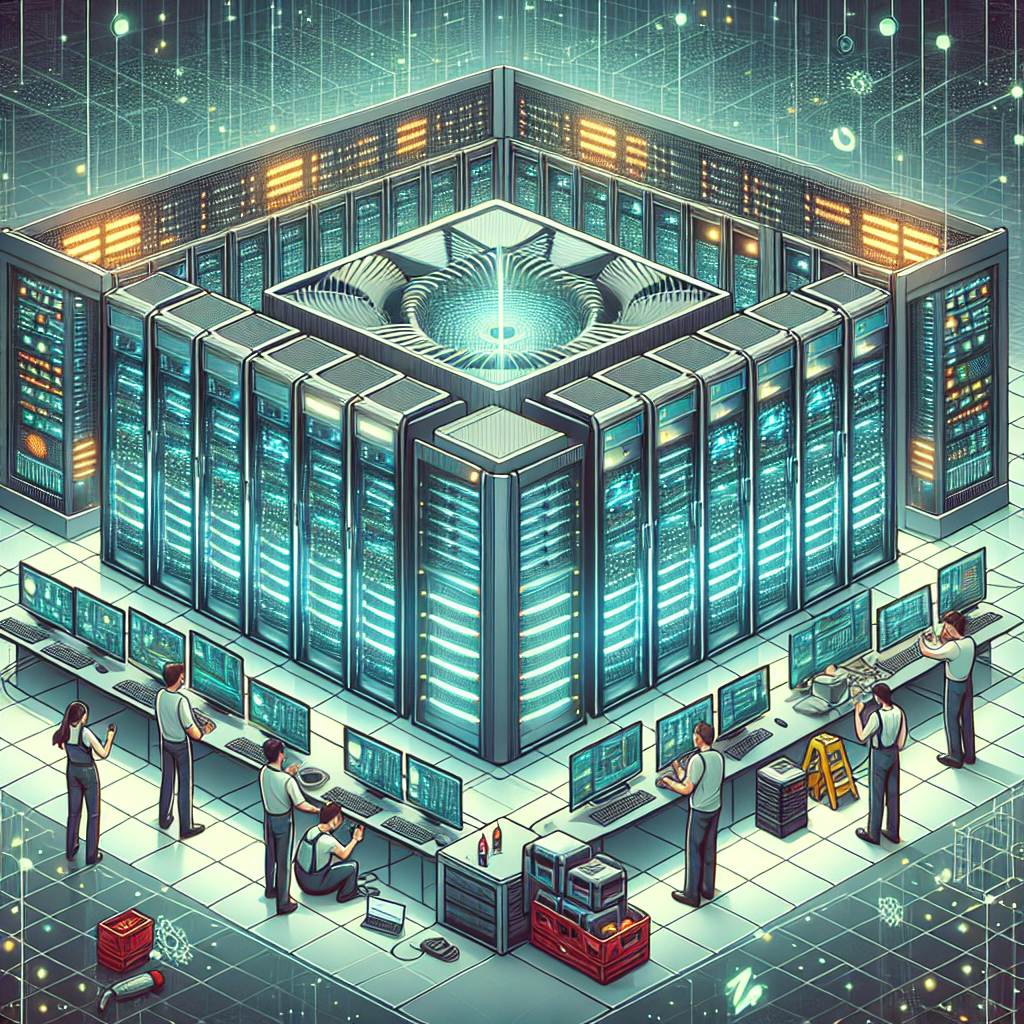Your cart is currently empty!
Tag: Optimal

The Importance of Regular Data Center Servicing: Ensuring Optimal Performance and Reliability
Data centers play a crucial role in today’s digital world, serving as the backbone of many businesses and organizations. They store and manage vast amounts of data, ensuring that critical information is accessible at all times. To maintain optimal performance and reliability, regular data center servicing is essential.Data centers are complex systems that consist of various components such as servers, storage devices, networking equipment, and cooling systems. These components must work together seamlessly to ensure that the data center operates efficiently and effectively. Regular servicing helps to identify and address any issues or potential problems before they escalate into more significant and costly issues.
One of the key benefits of regular data center servicing is the prevention of downtime. Downtime can have a significant impact on businesses, causing lost revenue, decreased productivity, and damage to reputation. By conducting regular maintenance and servicing, potential issues can be identified and resolved before they lead to downtime. This proactive approach helps to ensure that the data center remains operational and reliable at all times.
Regular servicing also helps to improve the performance of the data center. Over time, components can become worn out or outdated, leading to decreased efficiency and performance. By conducting regular maintenance, outdated equipment can be replaced, and systems can be optimized to enhance performance. This results in faster data processing, improved response times, and a better overall user experience.
In addition to preventing downtime and improving performance, regular data center servicing is also essential for ensuring the security of the data stored within the center. Cyber threats are constantly evolving, and data centers are prime targets for hackers looking to steal sensitive information. By conducting regular security audits and updates, data center operators can identify and address vulnerabilities, helping to protect data from potential breaches.
Overall, the importance of regular data center servicing cannot be overstated. By investing in routine maintenance and servicing, businesses can ensure that their data centers operate at peak performance, remain reliable, and are secure from potential threats. This proactive approach helps to safeguard critical data, minimize downtime, and maximize the efficiency and effectiveness of the data center. In today’s digital age, where data is king, regular servicing is essential to maintaining a competitive edge and ensuring the success of a business or organization.

Data Center Capacity Planning Best Practices for Optimal Performance
In today’s digital age, data centers play a crucial role in storing and managing the vast amount of information generated by businesses and individuals. With the increasing reliance on data-driven decision-making and the rise of technologies like cloud computing and big data analytics, the demand for data center capacity has never been higher. To ensure optimal performance and efficiency, it is essential for organizations to engage in effective data center capacity planning.Data center capacity planning involves determining the amount of computing resources, storage, and networking infrastructure needed to support the current and future needs of an organization. By accurately forecasting demand and scaling resources accordingly, businesses can avoid costly downtime, improve resource utilization, and enhance overall performance.
To achieve optimal performance, organizations should follow best practices for data center capacity planning:
1. Conduct a thorough assessment of current and future needs: Before embarking on capacity planning, it is essential to understand the current workload demands and future growth projections. This includes analyzing data usage patterns, application requirements, and business objectives to determine the necessary resources.
2. Implement a scalable infrastructure: To accommodate future growth and fluctuations in demand, organizations should invest in a scalable infrastructure that can easily expand or contract as needed. This may involve deploying virtualization technologies, cloud services, or modular data center designs.
3. Monitor and analyze performance metrics: Regularly monitoring key performance indicators (KPIs) such as CPU utilization, memory usage, network traffic, and storage capacity can provide valuable insights into resource allocation and identify potential bottlenecks. By analyzing performance metrics, organizations can proactively address capacity issues before they impact operations.
4. Utilize predictive analytics: Leveraging predictive analytics tools can help organizations forecast future demand and optimize resource allocation. By analyzing historical data and trends, businesses can make informed decisions about capacity planning, ensuring they have the right resources in place when needed.
5. Plan for redundancy and disaster recovery: To ensure high availability and minimize downtime, organizations should implement redundancy measures and disaster recovery plans. This may involve deploying backup systems, failover mechanisms, and data replication strategies to mitigate the impact of hardware failures or natural disasters.
6. Collaborate with stakeholders: Effective capacity planning requires collaboration between IT, business stakeholders, and senior management. By involving key decision-makers in the planning process, organizations can align capacity requirements with business objectives and ensure that resources are allocated efficiently.
In conclusion, data center capacity planning is essential for optimizing performance and maximizing efficiency in today’s data-driven business environment. By following best practices and leveraging technology tools, organizations can effectively forecast demand, scale resources, and ensure high availability to meet the evolving needs of the organization. By investing in capacity planning, businesses can stay ahead of the curve and leverage data center infrastructure as a competitive advantage.

Maintaining and Testing Data Center Generators for Optimal Performance
Data center generators are a critical component of a facility’s backup power supply system. In the event of a power outage, these generators are responsible for keeping essential equipment running and ensuring uninterrupted access to data and applications. To ensure that data center generators are ready to perform when needed, regular maintenance and testing are essential.Regular maintenance is key to keeping data center generators in optimal condition. This includes routine checks of fuel levels, oil levels, and coolant levels. It is important to ensure that the generator is properly fueled and lubricated to prevent mechanical failures. In addition, filters should be changed regularly to ensure that the generator is operating efficiently.
Regular testing is also crucial to ensure that data center generators are functioning properly. Testing should be done on a regular basis to verify that the generator can start up and run smoothly in the event of a power outage. This can involve running the generator under load for a specified period of time to ensure that it can handle the necessary workload.
Testing can also help identify any potential issues with the generator before they become major problems. For example, testing can reveal issues with fuel delivery or cooling systems that need to be addressed before they cause a failure during an actual power outage.
In addition to regular maintenance and testing, it is important to have a comprehensive maintenance plan in place for data center generators. This plan should outline the frequency of maintenance tasks, as well as the procedures for testing and troubleshooting any issues that may arise. It is also important to have a backup plan in place in case the primary generator fails to start or operate properly.
By maintaining and testing data center generators regularly, facilities can ensure that they are prepared for any power outage that may occur. This can help prevent costly downtime and ensure that critical systems remain operational in the event of an emergency. With proper maintenance and testing, data center generators can provide reliable backup power when it is needed most.

How to Streamline Data Center Operations for Optimal Efficiency
In today’s digital age, data centers play a crucial role in storing, processing, and managing vast amounts of information for businesses of all sizes. However, as data continues to grow exponentially, data center operations are becoming more complex and challenging to manage efficiently. To ensure optimal performance and efficiency, it is essential to streamline data center operations. Here are some key strategies to help businesses achieve this goal:1. Consolidate and Virtualize Servers: One of the most effective ways to streamline data center operations is to consolidate servers and virtualize workloads. By reducing the number of physical servers in the data center and running multiple virtual servers on a single physical machine, businesses can optimize resource utilization, reduce energy consumption, and improve overall efficiency.
2. Implement Automation: Automation is a powerful tool for streamlining data center operations. By automating routine tasks such as provisioning, monitoring, and troubleshooting, businesses can reduce manual effort, minimize human errors, and increase operational efficiency. Automation tools can also help optimize resource allocation, improve scalability, and enhance agility in response to changing business needs.
3. Optimize Cooling and Power Management: Cooling and power are critical components of data center operations, as they account for a significant portion of energy consumption. To improve efficiency, businesses should optimize cooling systems by using energy-efficient cooling technologies, implementing hot and cold aisle containment, and maintaining proper airflow management. Additionally, businesses can reduce power consumption by implementing power management tools, using energy-efficient hardware, and adopting best practices for power distribution and redundancy.
4. Monitor and Analyze Performance: To streamline data center operations, businesses must continuously monitor and analyze the performance of their infrastructure. By collecting and analyzing data on key performance metrics such as server utilization, network traffic, and storage capacity, businesses can identify bottlenecks, optimize resource allocation, and proactively address issues before they impact performance. Monitoring tools can also help businesses track trends, forecast future capacity requirements, and make data-driven decisions to improve efficiency.
5. Implement Disaster Recovery and Business Continuity Plans: Data center downtime can have severe consequences for businesses, including lost revenue, damage to reputation, and potential legal liabilities. To ensure optimal efficiency, businesses should implement robust disaster recovery and business continuity plans to minimize downtime and ensure data availability in the event of a disaster. By establishing redundant systems, implementing data replication and backup strategies, and regularly testing recovery procedures, businesses can mitigate risks and maintain operational continuity.
In conclusion, streamlining data center operations is essential for businesses to achieve optimal efficiency, reduce costs, and enhance performance. By consolidating servers, implementing automation, optimizing cooling and power management, monitoring performance, and implementing disaster recovery plans, businesses can streamline their data center operations and position themselves for success in today’s competitive business environment.

Best Practices for Data Center Cabling: Tips for Optimal Performance
Data center cabling is a crucial aspect of any IT infrastructure, as it plays a key role in ensuring optimal performance and reliability. With the increasing complexity of data center environments and the growing demand for high-speed connectivity, it is essential to follow best practices for data center cabling to avoid downtime and ensure smooth operations.Here are some tips for achieving optimal performance with data center cabling:
1. Plan and design your cabling infrastructure carefully: Before you start cabling your data center, it is important to have a clear plan and design in place. Consider factors such as the layout of your data center, the number of racks and servers, and the type of cabling required. This will help you avoid unnecessary cable clutter and ensure a clean and organized cabling infrastructure.
2. Use high-quality cables and connectors: Invest in high-quality cables and connectors that meet industry standards for performance and reliability. Using low-quality cables can lead to signal degradation, interference, and data loss, resulting in poor network performance. Choose cables that are rated for the speed and bandwidth requirements of your data center.
3. Label and document your cables: Proper labeling and documentation of cables are essential for troubleshooting and maintenance tasks. Make sure to label each cable with a unique identifier and document the connections in a cable management system. This will help you easily identify and trace cables when needed, saving time and effort.
4. Use cable management tools and techniques: Proper cable management is crucial for maintaining a neat and organized cabling infrastructure. Use cable management tools such as cable trays, racks, and ties to keep cables organized and prevent tangling. Avoid running cables near sources of interference, such as power cables or heating vents, to ensure optimal performance.
5. Follow industry standards and best practices: Adhering to industry standards such as TIA/EIA and ISO/IEC for cabling design and installation is essential for ensuring reliability and performance. Follow best practices for cable routing, spacing, and termination to minimize signal loss and ensure maximum throughput.
6. Regularly inspect and maintain your cabling infrastructure: Regular inspections and maintenance of your cabling infrastructure are essential for preventing issues such as cable damage, wear and tear, and signal degradation. Conduct routine checks to identify and address any issues before they cause downtime or performance issues.
By following these best practices for data center cabling, you can ensure optimal performance, reliability, and efficiency in your IT infrastructure. Investing in high-quality cables, proper planning, and maintenance will help you avoid costly downtime and keep your data center running smoothly.

The Importance of Data Center Facilities Management: Ensuring Optimal Performance and Efficiency
Data centers play a crucial role in the modern digital world, serving as the backbone of countless businesses and organizations. These facilities house and manage the critical infrastructure needed to support the operation of servers, storage devices, networking equipment, and other IT components. To ensure optimal performance and efficiency, data center facilities management is essential.Facilities management encompasses a range of tasks and responsibilities that are vital to the smooth operation of a data center. This includes everything from ensuring the physical security of the facility to maintaining the proper environmental conditions for the equipment housed within. By effectively managing these aspects, data center operators can minimize downtime, improve energy efficiency, and maximize the lifespan of their equipment.
One of the key responsibilities of data center facilities management is maintaining the proper temperature and humidity levels within the facility. IT equipment is sensitive to fluctuations in temperature and humidity, and failure to maintain the ideal conditions can result in equipment failure and downtime. By monitoring and controlling these factors, facilities managers can ensure that the equipment operates at its peak performance levels.
Another important aspect of data center facilities management is ensuring the physical security of the facility. Data centers house a wealth of sensitive information and valuable equipment, making them a prime target for theft and vandalism. By implementing security measures such as access control systems, surveillance cameras, and security guards, facilities managers can protect the facility and prevent unauthorized access.
In addition to these tasks, data center facilities management also involves regular maintenance and upkeep of the equipment housed within the facility. This includes tasks such as cleaning the equipment, replacing worn-out components, and performing routine inspections to identify potential issues before they escalate into major problems. By staying on top of maintenance tasks, facilities managers can prolong the lifespan of the equipment and reduce the risk of unexpected downtime.
Overall, data center facilities management is essential for ensuring the optimal performance and efficiency of a data center. By effectively managing the physical environment, security, and maintenance of the facility, data center operators can minimize downtime, improve energy efficiency, and maximize the lifespan of their equipment. In today’s digital world, where data is king, the importance of data center facilities management cannot be overstated.

The Importance of Regular Data Center Servicing: Ensuring Optimal Performance and Security
Data centers are the backbone of modern businesses, serving as the central hub for storing, processing, and managing vast amounts of digital information. With the increasing reliance on technology and data-driven decision making, the importance of regular data center servicing cannot be overstated.Ensuring optimal performance and security of a data center is essential for maintaining the efficiency and effectiveness of a company’s operations. Regular servicing helps to identify and address potential issues before they escalate into major problems that could disrupt business operations or compromise sensitive information.
One of the key benefits of regular data center servicing is the optimization of equipment performance. Over time, hardware components such as servers, storage devices, and networking equipment can degrade or become outdated, resulting in decreased efficiency and reliability. By conducting routine maintenance and upgrades, organizations can ensure that their data center infrastructure is running at peak performance levels, maximizing productivity and minimizing downtime.
In addition to performance optimization, regular servicing also plays a critical role in enhancing data center security. With the increasing prevalence of cyber threats and data breaches, it is essential for organizations to implement robust security measures to protect their sensitive information. Regular servicing helps to identify vulnerabilities in the data center infrastructure, such as outdated software, misconfigured settings, or unauthorized access points, and take proactive steps to address them before they are exploited by malicious actors.
Furthermore, regular servicing can also help organizations comply with regulatory requirements and industry standards related to data security and privacy. By conducting regular audits and assessments, organizations can ensure that their data center infrastructure meets the necessary compliance standards, reducing the risk of potential fines or penalties for non-compliance.
Overall, the importance of regular data center servicing cannot be overstated. By investing in routine maintenance and upgrades, organizations can ensure that their data center infrastructure remains secure, reliable, and efficient, enabling them to leverage the power of data to drive business success. To learn more about how regular servicing can benefit your organization, contact a reputable data center service provider today.

The Importance of Data Center Monitoring: Ensuring Optimal Performance and Security
In today’s digital age, data centers play a crucial role in storing, processing, and managing vast amounts of information for businesses and organizations. With the increasing reliance on technology and the exponential growth of data, it has become more important than ever to monitor and manage data center performance and security effectively.Data center monitoring is the process of tracking, analyzing, and managing the performance and security of a data center infrastructure. This includes monitoring server health, network traffic, power consumption, cooling systems, and overall data center operations. By continuously monitoring these key metrics, organizations can ensure that their data center operates at optimal performance and remains secure from potential threats.
One of the primary reasons why data center monitoring is essential is to prevent downtime. Downtime can be incredibly costly for businesses, resulting in lost revenue, damaged reputation, and decreased productivity. By monitoring the performance of servers, storage systems, and network infrastructure, IT teams can proactively identify and address issues before they escalate into major outages.
Furthermore, data center monitoring is crucial for ensuring data security. With the increasing frequency and sophistication of cyber attacks, organizations must be vigilant in monitoring their data center infrastructure for any signs of unauthorized access or suspicious activity. By monitoring network traffic, system logs, and security alerts, IT teams can quickly detect and respond to potential security breaches.
In addition to preventing downtime and enhancing security, data center monitoring also helps organizations optimize resource utilization and improve overall efficiency. By monitoring power consumption, cooling systems, and server utilization, organizations can identify opportunities to reduce energy costs, streamline operations, and maximize the performance of their data center infrastructure.
Overall, data center monitoring is a critical component of modern IT operations. By continuously monitoring and managing data center performance and security, organizations can ensure that their data center operates at peak efficiency, remains secure from potential threats, and delivers the reliability and performance needed to support their business operations. Investing in robust data center monitoring solutions is essential for any organization looking to stay ahead in today’s fast-paced and data-driven business environment.

The Importance of Regular Data Center Inspections: Ensuring Optimal Performance and Security
Data centers are the backbone of modern businesses, providing the infrastructure necessary to store, process, and manage critical information. With the increasing reliance on digital technology, the importance of data centers cannot be overstated. However, despite their crucial role, data centers are often overlooked when it comes to maintenance and inspections.Regular data center inspections are essential to ensure optimal performance and security. By conducting routine checks and assessments, businesses can identify potential issues before they escalate into major problems. This proactive approach not only helps prevent costly downtime but also ensures that data center operations run smoothly and efficiently.
One of the key reasons why regular inspections are important is to maintain the integrity of the data center’s infrastructure. Over time, equipment and systems can degrade or malfunction, leading to potential failures. By inspecting critical components such as servers, cooling systems, and power supply units, businesses can address any issues promptly and prevent disruptions to their operations.
In addition to maintaining optimal performance, regular inspections also play a crucial role in ensuring the security of the data center. With cyber threats on the rise, it is more important than ever for businesses to protect their sensitive information. By conducting thorough security audits and assessments, businesses can identify vulnerabilities and weaknesses in their data center’s security measures and take appropriate action to mitigate risks.
Furthermore, regular inspections can also help businesses comply with industry regulations and standards. Many industries, such as healthcare and finance, have strict data security requirements that businesses must adhere to. By conducting regular inspections and audits, businesses can demonstrate their commitment to maintaining a secure and compliant data center environment.
Overall, regular data center inspections are essential for businesses to ensure optimal performance and security. By proactively identifying and addressing potential issues, businesses can minimize downtime, protect their data, and comply with industry regulations. Investing in regular inspections is a small price to pay for the peace of mind that comes with knowing that your data center is operating at its best.

The Importance of Data Center Reactive Maintenance: Ensuring Optimal Performance and Reliability
Data centers are the backbone of modern technology, serving as the central hub for storing, processing, and distributing data. These facilities are critical to the operations of businesses, organizations, and even individuals who rely on the seamless functioning of their digital infrastructure. To ensure optimal performance and reliability, data center reactive maintenance plays a crucial role.Reactive maintenance refers to the practice of addressing issues as they arise, rather than proactively preventing them. While proactive maintenance is important in preventing potential problems, reactive maintenance is equally essential in responding swiftly to unexpected issues that can disrupt the operation of a data center.
The importance of data center reactive maintenance cannot be overstated. In a fast-paced digital environment where downtime can result in significant financial losses and damage to reputation, swift response to issues is essential. By promptly addressing issues as they arise, data center operators can prevent minor problems from escalating into major outages that can have far-reaching consequences.
One of the key benefits of reactive maintenance is its ability to minimize downtime. When an issue occurs in a data center, every minute of downtime can result in lost revenue and productivity. By responding quickly and efficiently to issues, data center operators can minimize the impact of disruptions and ensure that operations are restored as soon as possible.
Reactive maintenance also plays a crucial role in maintaining the reliability of a data center. By promptly addressing issues, operators can prevent them from recurring and ensure that the facility operates at peak performance. This not only enhances the overall efficiency of the data center but also helps to build trust with clients and users who rely on the facility to store and process their data.
In addition to minimizing downtime and ensuring reliability, reactive maintenance also helps to extend the lifespan of data center equipment. By promptly addressing issues and conducting repairs as needed, operators can prevent equipment from deteriorating and ensure that it continues to function effectively for years to come.
Overall, the importance of data center reactive maintenance cannot be underestimated. By responding swiftly to issues, minimizing downtime, ensuring reliability, and extending the lifespan of equipment, operators can ensure that their data center operates at optimal performance and remains a reliable and efficient hub for storing and processing data. In today’s digital age, where data is king, reactive maintenance is a critical component of maintaining a successful data center operation.
